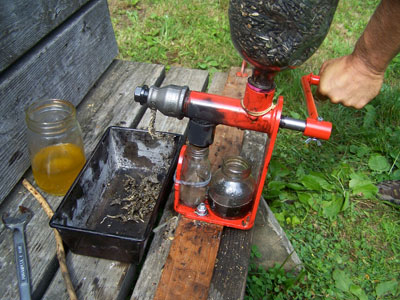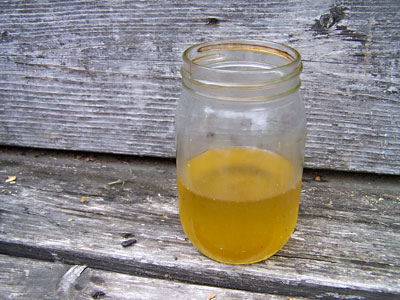 |
| Oil being expressed from black oil sunflower seeds in a Piteba press. Photos by Anita Budhraja. |
 |
| After the oil has been pressed and the sediment and pigment allowed to settle for hours, the product is decanted, giving finished, ready-to-use oil. |
By Will Bonsall
Those of us who seek to be more self-reliant are often content to grow our own veggies and perhaps some of our legumes, such as peas and beans. The more extremist among us may also aspire to producing our own grains, which after all have been the staff of life for most of mankind through most of our history. But what about fat or oil? For meat eaters, suet and lard are rather simple options, although at a great loss of eco-efficiency. From our first years on the land, we aspired to produce our own vegetable oil, but that seemed elusive until recently.
The two main oil crop options I recognized for my cool northern farm were rape seed/canola and sunflower seeds. One year we grew a half bushel of rapeseed – very easy to grow and clean – but had no means to press the oil. Also it occurred to me that I would have a lot of spent oilseed cake for which I had no use (pretty eco-inefficient compost); even if I had livestock, it is not a safe fodder for all kinds. In fact, we did not waste all that rapeseed; we found it superb for sprouting and a valuable additive to green-manure mixes (if you have flea beetles under control). But that did nothing for our oil needs.
Sunflowers had the same problem – the waste – only with an added twist: There are two types of sunflowers, oilseed and confection. We had been growing the latter and hulling them in a borrowed rice huller. Actually, that was ideal, as we got to eat the whole seed, as opposed to extracting the oil and discarding the cake. Moreover, while the oil could have come from other sources (our bodies can make it out of starch), the protein, vitamins and especially trace minerals are harder to get elsewhere.
Later we came to appreciate pepitas – naked-seeded pumpkins – as they were a whole oilseed, used much like the de-hulled sunflowers. Again, it was great to have the entire seeds with their whole complement of other nutrients, but it still begged the question: How can we grow and process our own oil?
About that time, some Seventh-Day Adventist friends dropped a quote from their founder, Ellen White, that oil should be eaten “as in the olive,” which some Adventists interpreted as meaning entire, unextracted. Well, we are not Adventists, but that bit made good sense to us, only how do we cook stuff that way? How do we stir-fry, make pancakes and salad dressing, pop popcorn, and so on? We experimented a lot and found ways of dealing with all those problems, using complete oilseeds, usually sunflower seeds and usually in the form of finely ground oily meal. That opened a whole new and delightful cuisine for us, and we managed nicely without extracted oil, although our diet was not particularly low in fat.
Over time we backslid, getting re-accustomed to extracted oil (although Maine-grown sunflower oil was still a huge advance on our old habits), which posed the old problem: However much or little oil we intend to use, how can we produce our own?
In doing research for my recent book, I came across a diminutive hand-powered oil press from Holland, called the Piteba. It clamps onto a rugged bench or table and extracts oil from a wide assortment of nuts and seeds (including coconuts and chufa, but not olives). Initial experiments with oil-type sunflowers (store-bought bird seed – all I had at the time) were frustrating, jamming the orifices every time and yielding little oil. A U.S. dealer in Washington advised me to dampen the seeds, since the hulls on long-stored seeds were often too dry and tough to pass through the exhaust ports. I tried that – about 2 tablespoons per pound – and let it set for a day or two, but although the hulls were indeed more elastic, the press still plugged up constantly. Finally it occurred to me: Maybe I’m being too wimpy with this thing. Despite its size (it comes in a padded mailer!), it seemed ruggedly built, so perhaps I just needed to crank harder. That stuff was really packed in there tightly, and I expected to need a jackhammer to unplug it. Then all of a sudden the residue began squeezing out the ports like toothpaste, and the oil ran freely, first as rapid drips and then as a thin, steady trickle.
I should mention that the press comes with a tiny kerosene burner to preheat the chamber and the oilseed as it enters the auger. This is important as the slight heat nearly doubles the yield of oil. You should realize that most or all “cold pressed” oil is slightly heated for yield. However, I don’t fancy burning kerosene around food, so I used a candle stub, and I plan to use a smaller one, since it doesn’t seem to require even as much heat as I have.
The sunflower oil came out an ugly gray color with some sediment, but after settling out for a few hours, it became a clearer light amber with a bit of easily separated sludge on the bottom. By the way, the black-seeded oil-type sunflowers (such as ‘Peredovik’) are difficult or impossible to de-hull, but no matter; for pressing you just grind the whole seed, which gives it the gray color that soon settles out. And the flavor? Absolutely nothing like it; why had I ever eaten any other kind of oil?
Next I was curious to try other seeds: What about pumpkins? Of course I already had the hull-less pumpkins, which are used in Eastern Europe to press vegetable oil, but since we could use those complete, why mess with extraction? On the other hand, every year we send lots of winter squash seed to the compost – could we salvage a bit of oil from that? Since it was a waste product anyway, the yield was not so critical as if we were growing it for the oil. Indeed they pressed quite well and yielded a reasonable quantity of exquisite tasting oil. Even after settling, the oil had a pronounced greenish tint from the chlorophyll content, but the taste was unimpaired; in fact it was exceptionally rich.
You might expect that anyone would be more than satisfied at wringing this gourmet food item from stuff that was bound for the compost heap, but not this greedy fellow. Years ago I had experimented with grinding squash or pumpkin seeds in my Corona mill, boiling it and sieving it to get an oily cream. Much of the finely ground hull passed through the screen and ruined the “cream.” However, I duplicated the experiment with the spent seed cake and it was completely successful, since pressing left the hulls crushed but too coarse to go through the strainer with the “cream.” Even after pressing, the thick watery extract is oily enough to make a rich cream sauce, which I use on veggies, especially peas, carrots and Brussels sprouts.
My success with squash seed reminded me of something I had read in Farmers of Forty Centuries, where the author describes street vendors in Chinese cities selling roasted peanut, sunflower seeds, pumpkin seeds and – get this – melon seeds! I couldn’t imagine snacking on such tough-hulled things, but might they too be pressed for oil? And what about cucumbers? I tried those in my Piteba and found the yield mediocre but the flavor to die for, much like butter with a faint nuance of pumpkin-ness. I would never recommend growing cukes or melons for their oil, but if one is growing them to eat the melons, why compost the seeds? And if cucumbers get by you, they’re not a complete waste.
I’ve also experimented with surplus Cruciferae, including radish and kale seeds (knowing that mustard oil is the most commonly used vegetable oil in south and central Asia). My results so far have been inconclusive but promising.
The Piteba is not practical for large-scale production. It requires tweaking to get the moisture level right, the proper heat, the adjustment on the pressure screw, but it is certainly not rocket science, and with a bit of patience at first, you can reasonably supply most or all of your family’s vegetable oil in your own home from home-grown seeds, with a flavor you just have to experience, and even from seeds that were previously wasted.
About the author: Will Bonsall lives in Industry, Maine, where he directs Scatterseed Project, a seed saving enterprise. His book, Gardens Without Borders, will be published by Chelsea Green and is due out in February. You can contact Will at [email protected].
